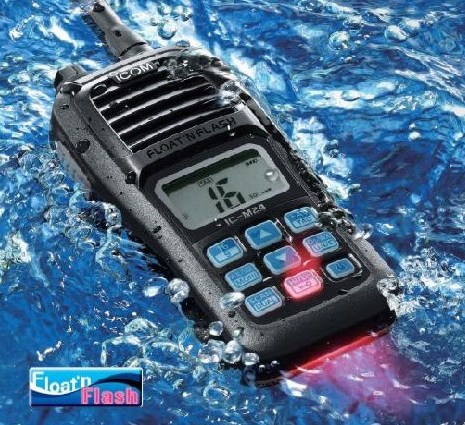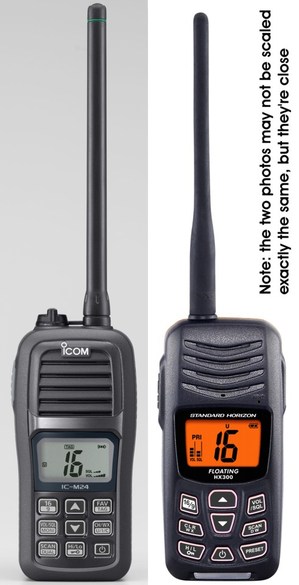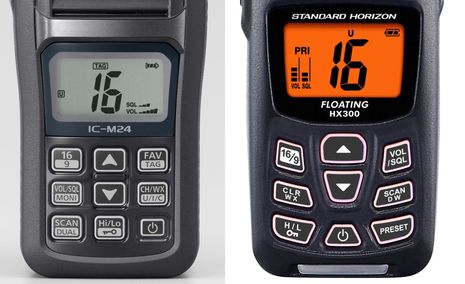Super light VHF handhelds: Icom M24 vs Standard Horizon HX300

I've been meaning to write about the Icom M24 handheld VHF for some time. While I haven't actually tested this model myself, just holding one at a boat show was a revelation about how light and hand-friendly a full-featured portable marine radio can be these days. Apparently Standard Horizon was also impressed, because today they announced an HX300 model that seems very similar...
I put a disclaimer on the comparison image below because I'm not positive I scaled the photos precisely, but while Icom specs the M24 at 9.2 ounces with a body W/H/D of 2.3" × 5.06" × 1.36", SH is claiming 8.8oz in 2.32" x 5" x 1.34". That's close! And it's remarkably light when you consider that each company's previous light weight floater -- the M34 (which I have tested and like a lot) and the HX290 -- come in at around 11oz. A couple of ounces carried around all day does make a difference. (By way of comparison, an iPhone 4S weighs 4.9oz.)
Yes, both the M24 and HX300 float, and they also both fire off flashing LEDs if dropped overboard. And both can transmit at 1 or 5 Watts and boast "powerful" 600 mW audio on the receive side. Plus both use cell-phone-style replaceable 3.7v Lithium-ion batteries. Icom rates its capacity at 1590 mAh or 10 hours of "typical operation" -- defined as 5% transmit, 5% receive, and 90% standby -- while Standard Horizon cites its battery as 1,650 mAh capacity, but so far without an estimated run time, which is not necessarily proportional due to variable power efficiency. Both radios have internal charging circuits, though Icom's is driven by an included 120/240v wall wart, or optional 12v cable while SH has gone with a standard USB charging interface. I don't know which charges faster...

So these are very similar, and similarly attractive, VHF handhelds. And they seemed priced reasonably, with the M24 now at about $130 on the street, which may come down when the HX300 starts shipping in January with a retail price of only $150 (assuming it receives FCC approval). What I can't really comment on yet is their comparative performance and operating systems. Sure both have similar "Tag" or "Preset" functions that let you specify the channels you like to scan, but SH is touting a new E2O (Easy To Operate) menu system that I'm not familiar with. It would be great to hear from readers who have lived with an M24, while we wait for Standard Horizon to put up an HX300 product page and for people to actually use them.
Incidentally, I don't mean to knock SH for trying to at least match some good ideas dreamed up by competitor. That's sensible, and generally good for consumers. Besides, Standard has plenty of innovations under its belt, and that definitly includes another radio announced today. That's the GX1700, the first fixed VHF radio with a GPS built in, as already noted by my friend Glenn Law. I'll have much more detail on it soon.


 Share
Share
Calling either of them "full featured" is a stretch. To me, at least, that description is inappropriate for any handheld lacking DSC + GPS, which for many near-costal and inland boaters can safely substitute for a PLB or even an EPIRB, at a fraction of the cost.
I'm on a major 125 mile-long lake, with the USCG VHF antenna mounted 6,000' above lake level...a handheld with DSC and GPS is perfect for those conditions, either as a back-up or for man-overboard.